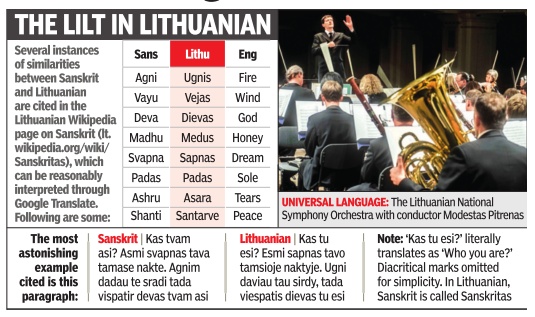Sanskrit: link with non-Indian languages
This is a collection of articles archived for the excellence of their content. |
Sanskrit and Lithuanian, similarities

From: Agniva Banerjee, Orchestra brings notes from Europe's north and living links with Sanskrit, October 14, 2017: The Times of India
By their looks, Lithuanians, who live right across the sea from the Swedes in Northern Europe, could hardly be described as cousins of Indians. But if one considered only speech, things would look more interesting. It turns out that Lithuanian is very close to Sanskrit, with many of its words and formations almost indistinguishable from India's much revered ancient tongue.(see graphic).
Thus, when members of the Lithuanian National Symphony Orchestra (LNSO), who were recently in Mumbai for two concerts, spoke among themselves, they used words and expressions as ancient as Sanskrit, but spoken through a living language. “We are visiting India for the first time,“ says the orchestra's chief conductor and artistic director Modestas Pitrenas. “We are proud to announce to all the world that our people came from India.This can be seen in our language, which preserves its ancient roots and has stayed more or less the same for thousands of years.“
That Lithuanians trace their ancestry to India is Baltic folklore. Linguists and population experts have a slightly different take.
In the evolving process of history , Sanskrit transitioned into modern languages like Hindi and Marathi, and is no longer spoken as a mother tongue by a reasonable number of people. But for various reasons such historic pressures weren't brought upon Lithuanian, which today retains characteristics from several millennia ago.Among the Indo-European languages (IELs), the world's widest spoken language group, which includes tongues as diverse as Assamese, Persian and English, Lithuanian is the one that bears the most similarities to Proto-Indo-European (PIE), the reconstructed common ancestor of this superfamily of languages (two other languages that are very close to PIE are Vedic Sanskrit and Ancient Greek). Though Lithuanian and Sanskrit belong to very different branches of IELs, they owe their similarities to Lithuanian's retention of PIE characteristics which have been lost in other living languages.
The Baltic languages' close links with Sanskrit may sound spectacular, but shouldn't be surprising as there's strong evidence that PIE originated in the Pontic Steppes (much of presentday Ukraine and parts of Moldova, Kazakhstan and Russia), from where it radiated outwards in waves of human migration. Some scholars say there is evidence that such an origin and development is also true of what today are known as Vedic practices. In this light, it is interesting to realise that Lithuanians were the last pagan people of Europe, before taking to a monotheistic faith in the late 14th century.